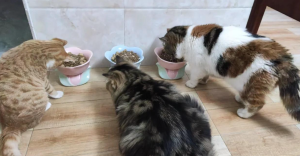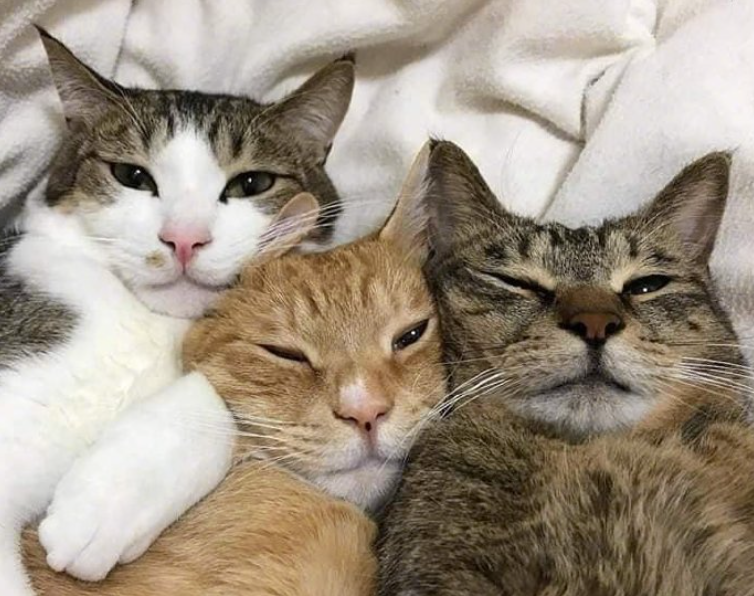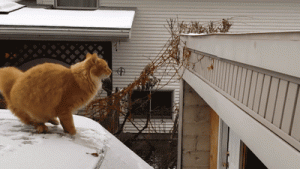In a household with two cats, if they don’t fight and politely queue up for meals, you might think their relationship is perfectly harmonious and peaceful, right? Well, that’s a huge mistake! Let me break it down for you slowly.In multi-cat households, if one cat always waits to see if the other cat has finished eating and is fully satisfied before daring to approach the food bowl, then it’s very likely that the cat is being bullied. Or, if one cat frequently sits by the litter box or watches over the food bowl, the other cat may be experiencing invisible bullying.This kind of “cold violence,” which doesn’t involve fights, hissing, or any external signs, can actually be more damaging than the more obvious physical bullying. The bullied cat may show signs of anxiety, excessive shedding, holding in urine, or even going hungry. Over time, these issues can lead to skin conditions or urinary tract problems.What might appear to be a peaceful multi-cat home is actually full of hidden dangers. It’s like when a child in school has a physical fight—they may get scolded, but it’s easier to address than a child who doesn’t fight but keeps saying they don’t want to go to school and is trying to avoid it.By following these two simple, cost-effective methods—without needing to isolate the cats—you can effectively alleviate the situation.
-
Adequate Resource Allocation
“Full granaries teach courtesy” – this applies to both humans and animals. Just look at the animals that went extinct through natural selection, most of them disappeared because they no longer had to worry about food, causing their offensive and defensive abilities to degrade, which ultimately led to their extinction. In a multi-cat household, placing more litter boxes around quiet corners of the house can make a big difference. This way, the bullied cat has different routes to access the litter box without having to pass by the bullying cat. It’s much harder for the bullying cat to guard multiple litter boxes. Similarly, ensure you have multiple food and water bowls placed in different areas. This can achieve two key goals: first, the bullying cat won’t feel that resources are scarce, which will reduce its aggressive competition. Second, the bullied cat will have various routes to access resources without encountering the bully.

-
Distract the Bullying Cat’s Attention
Find ways to consume the bullying cat’s energy and physical strength. If you have time, interacting with the cat and getting it to exercise is an effective method. If you don’t have much time, you can spend a few bucks on some cat toys, such as ocean balls, electric mice, feather toys, or cat tunnels. This way, you’ll not only tire out the bullying cat, leaving it with less energy to pick on the other, more timid cats, but also help it develop the habit of hunting appropriate prey rather than seeing the other cat as a target or practice for its hunting skills.
-
How to Identify Invisible Bullying in Your Household
①Increased Hiding Time: If one cat in a multi-cat household always hides in dark places and you rarely see it, it’s likely avoiding aggression from other cats or even dogs.Solution: Place a couple of cat beds in high or secluded areas so the cat has its own space to feel safe.②Loss of Appetite or Refusal to Eat or Drink: While it’s common for cats to eat less during the summer, if the decrease is significant or the cat refuses to eat or drink altogether, you should pay close attention. It’s possible that its food is being guarded or monopolized by another cat.Solution: Feed the cats separately, ensuring each one has its own food and water bowls. If the appetite issue is severe, a vet visit is necessary to rule out any underlying health problems.③Excessive Grooming or Hair Loss: This can be a sign of anxiety or stress.Solution: Provide secure hiding spots, enrich the environment with more toys, and consider using pheromone diffusers to help alleviate anxiety.④Abnormal Urination or Defecation: The cat may avoid using the shared litter box out of fear.Solution: Provide more litter boxes—at least one more box than the number of cats—and ensure they are kept clean.⑤Overly Polite Behavior: If a cat is excessively polite, always stepping aside, watching the other cat eat before it does, following the other cat when entering or exiting a room, and staying in the background when the owner interacts with the other cat, it might not just be well-behaved—it may be too scared to compete for attention.Solution: Ensure there are plenty of resources available for all cats, so no one feels deprived. If needed, separate the cats to reduce tension.
So, fellow cat lovers, is your household a multi-cat home or do you have a single feline child? Have you experienced any of the situations mentioned above in your multi-cat household? If you have better solutions or tips, feel free to share them in the comments section. Let’s exchange ideas and practice responsible, science-based cat care!





